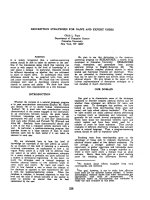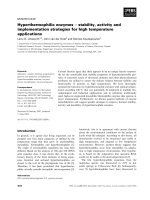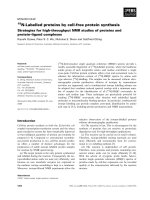Forex Strategies for High and Low Volatility Markets_3 pdf
Bạn đang xem bản rút gọn của tài liệu. Xem và tải ngay bản đầy đủ của tài liệu tại đây (1.36 MB, 32 trang )
Mastering the Currency Market
116
of thumb, the smaller the retracement, the stronger the origi-
nal move. For example, a 0.382 percent retracement after
a move generally indicates a stronger likelihood of a continu-
ation of the original move beyond its previous high or low
compared with a 0.618 retracement. It’s also important to note
the distance of the previous retracement, as often that meas-
urement becomes a characteristic and thus repeats itself. As
always, it’s very important to have enough information in the
form of time on the chart to avoid being caught measuring
retracements of a minor move or retracements of a retracement
and miss the long-term trend or the big picture.
Figure 5-30 shows how USDJPY falls into a pattern of 0.382
percent retracements as it gives us three in a row. It is not
Figure 5-29 Fifty Percent Retracement Level Holds in USDJPY
Support and Resistance
117
uncommon to see price movement break down so cleanly into
measured retracements. This type of predictability, however,
generally is found only in very liquid—that is, very heavily
traded—securities, currencies, and commodities.
Figure 5-31 shows GBPUSD completing a perfect 50 percent
retracement on a 60-minute chart just ahead of a powerful rally
after the U.S. nonfarm payroll news release on June 6, 2008.
Figure 5-32 shows the intersection of a 0.618 percent retrace-
ment and a bull trendline hold on a 240-minute chart, followed
by a powerful rally that quickly reversed the previous session’s
sell-off and confirmed the long-term uptrend. Also note the
sizable change-of-direction candle that kicked off the up move.
In Figure 5-33 we’ve included a 60-minute chart of the same
Figure 5-30 Three 0.382 Percent Retracements in a Row
Mastering the Currency Market
118
Figure 5-32 A 0.618 Percent Retracement on a 240-Minute USDJPY Chart
Figure 5-31 Fifty Percent Retracement on a 60-Minute GBPUSD Chart
after an Economic Release
Support and Resistance
119
period to highlight the same buy trigger on the next lower
time frame.
Figure 5-33 shows the same day we just examined, but on
the next lower time frame. Here we again see a change-of-
direction candle, this time on the 60-minute chart. Of course
we don’t know at the time that this intersection of a trendline
and a 0.618 percent retracement will hold, but when we see the
change-of-direction candle put in the double bottom here, just
below 104, we don’t think, we buy.
Although Fibonacci retracements are more of a countertrend
tool in that they measure primarily corrective price behavior,
Fibonacci extensions are a trending tool because they are
Figure 5-33 Intersection of Bull Trendline and 0.618 Percent Retracement
in a USDJPY Chart
Mastering the Currency Market
120
projecting, or forecasting, targets ahead of the market. An
extension would be taken by observing a market move fol-
lowed by a retracement, measuring the original move, and
then taking the same height and extrapolating it up or down
from the depth or height of the retracement back in the direc-
tion of the longer-term trend by a multiple of 0.618, 1, or 1.618;
one also could use any other multiple. To simplify it, we often
are looking for a move to repeat itself, or extend 100 percent of
itself. This means that if a stock went from 1 to 2 and then back
to 1.5, a 100 percent extension of that original move, as meas-
ured from the bottom of the retracement or correction at 1.5,
would be a move to 2.5.
Figure 5-34 Textbook Extensions on a Daily GBPUSD Chart
Support and Resistance
121
Figure 5-34 shows a USDJPY chart in which we’ve measured
the June-August sell-off and used the height of that move when
taken from the September-October retracement to measure
down and give us a target for the next leg lower. We also get a
third leg down in February-March, which happens to bottom
just below the 1.618 extension given to us from the first leg from
the previous summer. Extensions are often effective, just as
retracements and other support and resistance levels are, because
traders know about them and heed them. For our analysis and
trading, we need to know when and where there are significant
levels on the chart so that we can take a closer look at price
behavior in the short-term time frames at those price levels.
Figure 5-35 A 100 Percent Extension on a Daily USDJPY Chart
Mastering the Currency Market
122
Figure 5-35 shows an example of a price move, in this
case a rally, followed by a second rally several weeks later of
nearly identical height and time. This is a classic case of mar-
ket symmetry. Note the pattern of higher lows and then the
two equal lows in May, which would also be called a double
bottom. A double bottom is a classic chart formation that will
be covered in the next part of this book. This is a very inter-
esting chart. Note how in early June there was a close above
the old May high, or a market “breakout,” and USDJPY quickly
extended its move to replicate the earlier rally. Studying charts
like this during off-market hours in a relaxed environment is
great experience for market students.
Figure 5-36 A 161.8 Percent Extension on a Daily GBPUSD Chart
Support and Resistance
123
Figure 5-36 shows a late summer rally in 2007 in GBPUSD
and then a sharp correction lower by approximately 66 percent
of the up move into mid-September, which provides a retrace-
ment from which to draw an extension higher. In this case the
market pulls up short of the 100 percent extension in early
October and proceeds to move sideways for much of the
month before slipping higher toward the end of the month. The
second close above the 100 percent extension proves to be a
“breakout” above both that level and the isolated high back in
July, and we get a very fast rally, or a climax rally, up to the
1.618 extension level.
Figure 5-37 A 100 Percent Extension on a Daily GBPUSD Chart
Mastering the Currency Market
124
The extensions we see most are the 100 percent measurements,
and Figure 5-37 shows one on the daily GBPUSD chart after a
brief sideways correction in late February-early March 2008.
We have seen how important support and resistance levels
are to markets and traders. We see support and resistance in
the form of previous daily highs and lows and the trendlines
created by them, pivot points on all time frames, and retrace-
ment and extension levels. As you can see, there are plenty of
levels for traders to be concerned about on a chart, but the
most important thing to remember is that we don’t respect the
level unless the market does that first. Although you may be
concerned about having so many lines on your chart, you can
relax because as you will see, the markets will tell you which
lines are significant. Technical analysis is, after all, an art and
is based on the assumption that “the charts tell us everything
the market knows about itself.” It’s up to us to stay loose and
keep an open mind so that we can see what the market is
telling us.
CHAPTER
Chart Patterns
N
ow that we understand how a chart is constructed and
how price action identifies significant support and resist-
ance levels, we will discuss chart patterns, which are formations
created by multiple support and resistance points and trend-
lines. Whether we know it or not, pattern-recognition skills play
a big part in our lives and those of the people around us. To talk
about price patterns on financial charts, we also must cover
price volume, which is the total number of actual securities or
contracts traded for a particular bar or candle; it tells us whether
the trader participation rate is high or low relative to what it
has been and whether volume is increasing or decreasing. The
candle pattern gives us the length of a price movement, and the
volume tells us the size of the participation rate. For securities,
commodities, and currency analysis, volume is of particular
importance at the potential inflection points in the chart
patterns where the trend shifts. Volume is displayed at the
bottom of the chart in a histogram and is used to confirm direc-
tion. If a breakout, or penetration of an important price level,
occurs on rising volume, it is considered more viable; if it occurs
125
6
on light volume, a continuation in the direction of the breakout
is considered less likely.
Although stocks and futures have actual volume indicators
available, most platforms for forex markets do not. Some chart
packages, however, have tick volume on their intraday forex
charts that mimics futures volume and is considered a viable
indicator. On some chart packages the volume histogram can
be colored; depending on whether the accompanying bar or
candle was higher or lower; a green volume histogram would
indicate that the candle closed higher than the open and a red
volume histogram would indicate that it closed lower.
Like the trendlines and the support and resistance points
that create them, chart patterns provide a concise picture of
buyer and seller participation. Chart patterns give us an
unbiased look at the pricing results of the demand bid for
and the supply offered in a market, and volume tells us how
much product or money actually changed hands. Technical
analysis is an art in which the chart is the canvas, support
and resistance lines are the brushstrokes, and patterns or for-
mations are the picture. For our study these patterns can be
broken down into two groups: continuation patterns and
reversal patterns. Continuation patterns tell us the market
probably is pausing, or is in a temporary holding pattern
before a resumption of the previous trend. Reversal patterns
tell us a trend may be ending and alert us to a potential
reversal in direction. Reversal patterns can be broken down
into the two subcategories of topping and bottoming pat-
terns. Volume acts as a further confirmation of pattern. For
continuation patterns we would expect actual volume to be
Mastering the Currency Market
126
modest or declining, and for potential reversal patterns we
would expect volume to be increasing; this is what we mean
when we say that volume confirms direction.
We will be covering the following price patterns:
Continuation Patterns
Bull and bear flag/pennant
Horizontal channel or rectangle
Symmetrical, ascending, and descending triangles
Cup and handle
Reversal Patterns
Double top and double bottom formations
Triple top and triple bottom formations
Head and shoulders top and bottom formations
Rising and falling wedge formations
A quick word on patterns before we cover them individu-
ally: A price pattern or formation should jump out at you to
be considered valid. It must be obvious to you and other
traders for it to be effective. Formations are created from
trendlines, and so the same nuances we learned about
trendlines—it takes only two points to draw them, and
support can become resistance and vice versa—apply to
price patterns.
We are going to cover continuation patterns first, because
in our trading careers we will see more of these than reversal
patterns. It is the nature of markets to trend more than they
reverse. We refer to these as continuation patterns, but there is
Chart Patterns
127
no assurance that they will in fact mark consolidation moves
until they actually do so.
Continuation Patterns
Flags
Flags, or pennants as some analysts call them, are short-term
continuation patterns that are created when a trending mar-
ket encounters support (or resistance) in the form of demand
(or supply) and price pauses and retraces or goes sideways—
i.e., flags—for a short period. A flag often comes in the mid-
dle of a move; hence the old trading floor saying “the flag flies
at half mast.” For a move to be recognized as a flag, there
must be a prior trend in place. This prior trend or directional
price movement is called the flagpole, and the price objective
once the flag is completed is a 100 percent extension of the
flagpole from the lowest price on the flag. To visualize what
this looks like, the market experiences a trending move, then
a brief countertrend move we know to be a flag, and then a
second trending move that continues in the same direction as
the first. Flag formations are common in many markets, and
the stronger the move before the flag is, the more likely it is
that we will see the market continue in the original direction
and complete the objective.
Figure 6-1 shows an example of a bull flag in the EURUSD
in October 2007. We’ve measured the height or price distance
of the flagpole before the flag and then measured a 100 percent
extension of that move from the low of the flag. The rally after
the bull flag was similar in both length and time.
Mastering the Currency Market
128
In the course of an up move or a down move it is common
to see a series of flags as the move develops and matures.
Figure 6-2 shows a series of bull flags in USDCHF in which
the tick volume is much higher on the rallies than on the flags.
This is textbook chart pattern analysis as higher volume is
confirming the up moves and lower volume is confirming
the countertrend price action, that is, the flags. Note also how
the impulse moves, or rallies, are very similar to one another
in height and distance. This symmetry is common in chart
formations.
Chart Patterns
129
Figure 6-1 The Flag Flies at Half Mast
In Figure 6-3 we see a bear flag in the stock market in 2007
that played out in the Dow Jones futures contracts. The mar-
ket makes a sharp impulse move down, followed by the flag,
and then a second continuation impulse move down. We
then get a hammer on the downside target (price objective).
As quickly as the July price break came, it was over in
August, and for all the economic drama the 1,500-point
sell-off brought, we were left with a simple symmetrical
Mastering the Currency Market
130
Figure 6-2 Series of Bull Flags on a USDCHD Daily Chart
formation that a student of technical analysis would find
predictable.
Figure 6-4 shows a series of orderly bear flags followed by
a sharp sell-off on August 7, 2008. Note how the tick volume
increased on each individual down bar, followed by volume
clusters before the price collapse. In markets we often see an
orderly price move to establish direction, then acceleration
on increasing volume, followed by a dramatic sell-off.
Chart Patterns
131
Figure 6-3 Textbook Bear Flag in U.S. Stock Market in August 2007
Horizontal Channel
The rectangle, or horizontal channel, is essentially a sideways
trading range that a market creates while consolidating a
previous impulse move. It can be thought of as a larger, par-
allel flag formation. The price objective once the channel is
broken is the same as the height of the channel, as can be seen
in Figure 6-5. Note how we are seeing the same tendencies
in price behavior and price objective over and over in each
example. In our experience technical analysis is less compli-
cated than people seem to want to make it.
Mastering the Currency Market
132
Figure 6-4 Series of Bear Flags on a Daily EURUSD Chart
Figure 6-6 shows EURJPY pausing and creating a sideways
channel before breaking out in the same direction in which
it entered the formation. This formation reminds us of the
importance of waiting for a close outside the resistance before
committing to a trade.
Triangles
A symmetrical triangle is a little more complex than the other
continuation patterns. The pattern requires at least two lower
Chart Patterns
133
Figure 6-5 Measured Breakdown after a Sideways Channel
highs and higher lows within the triangle and usually shows
three, and it tends to break out of the formation in the same
direction in which it was traveling when it created the base.
These formations are characteristically larger than flags and
take more time to develop. As in any breakout, we must wait
for the candle to close outside the formation. There are two
different ways to measure the price objective. First, we take the
height of the base of the formation; in Figure 6-7 we’ve marked
a thin gray line to mark the base and extrapolated that distance
from the breakout or apex of the formation to get the price
objective. The other way to determine the objective is to take
Mastering the Currency Market
134
Figure 6-6 Sideways Pause before Resumption of Move
the support or resistance line from which the price broke
away—the dominant trendline—and copy or extend it from the
base. Both of these measurements give us the same approximate
time and price point in July 2008.
We now understand what makes a continuation pattern
what it is—price will look to continue in the direction it was
moving in before pausing in a pattern—but we also must
always remind ourselves that there are times when markets
reverse and what starts out looking like a continuation
pattern will turn into a reversal pattern. This is why experi-
enced traders always wait for a close above or below the
Chart Patterns
135
Figure 6-7 Symmetrical Triangle with the Objective Reached
appropriate support or resistance level before committing to
a trade.
Two more continuation patterns are the ascending triangle
and the descending triangle. The ascending triangle is a bullish
formation that more often than not marks a price pause, or con-
solidation phase, but it can come at the end of a down move and
mark a reversal. Wherever they occur on the chart or in the
trend, ascending triangles are marked by a horizontal resistance
line on top and an angled support line below moving from
left to right and connecting higher lows. The rising formation
indicates accumulation. Figure 6-8 shows an ascending triangle
Mastering the Currency Market
136
Figure 6-8 Ascending Triangle
in the U.S. stock market in 2003 that stands out nicely on the
chart. The hallmark of this formation is its right-angle appear-
ance; it must have at least two high points at the approximate
same level and at least two low points, with the most recent
being higher than the previous one. As in all technical breakouts,
volume should be increasing if there is to be an expected follow-
through of the move. The price objective of the formation can be
calculated by measuring the base of the triangle and extrapolat-
ing that distance from the breakout point.
A descending triangle is a bearish formation that, like an
ascending triangle, is more often a continuation pattern, but it
Chart Patterns
137
Figure 6-9 Descending Triangle
also can be a reversal pattern. It is a right-angle triangle with
at least two low points at approximately the same price level
and at least two high points, with the most recent being lower
than the previous one. Because of the lower lows of the
descending triangle, it has a definite bearish lean even before
the breakout. The price objective of the formation can be cal-
culated by measuring the height of the base of the triangle and
taking that measurement and extending it down from the
breakout point.
Figure 6-9 shows a descending triangle on the USDCHF
weekly chart in 2006-2007 that lasted for over a year and a half.
Cup and Handle
The cup and handle (Figure 6-10) is a bullish continuation pat-
tern that is named for its resemblance to a teacup with a han-
dle. The cup is a rounded consolidation pattern that forms after
a price advance, and the handle is a bull flag that launches an
upside breakout. The depth of the cup generally will not
retrace more than half the previous advance, ideally less. There
also has to be a marked increase in volume after the price
advance from the handle. The minimum price objective of the
breakout is equal to the distance from the bottom of the cup to
the top of the handle.
Let us remind you again that a chart formation should pop
out at you when you glance at the chart. As a rule of thumb,
the more obvious the formation is, the more likely it is that it
will play out and its price objective will be achieved.
We are going to cover reversal patterns next, and it’s impor-
tant to remember that these topping or bottoming patterns are
Mastering the Currency Market
138
not nearly as common as continuation patterns. A word of cau-
tion is due in addressing reversal patterns, particularly on long-
term charts, because they occur less often. There is something in
human nature that makes us feel we need to change things for
the better. Beginning students imagine that they can discern a
change in the market before the rest of us and call a market top
or bottom and maximize their profits along the way. Experi-
enced traders know better and are more interested in going
along with the market, which means trading through more con-
tinuation patterns than reversal patterns. It is best to understand
this human tendency to change things at the very beginning of
Chart Patterns
139
Figure 6-10 Cup and Handle
a trading career. The only thing we need to change as traders is
our perceptions of our significance in the face of the market.
Reversal Patterns
Double Top and Double Bottom
Double tops and double bottoms are reversal patterns that
occur when and where a price meets support or resistance once
and then backs off and attempts a second breach before failing
and retreating.
A double bottom is a reversal formation marked by two legs
at roughly the same price level with a small up move in between
on low volume. This bottoming pattern generally occurs at the
end of a sustained down move. A double bottom is not con-
firmed until price closes above the highest price between the two
legs (or lows), which is called the breakout point. Volume gen-
erally should increase once price closes above the breakout
point for the price to move higher and achieve its objective. The
price objective for the formation is an up move equal to the
height from the lowest leg to the highest point between the legs.
A double bottom creates a strong support level.
Figure 6-11 shows the symmetry created by a double bottom
in USDCAD in 2001 as price reached its objective and con-
formed around that level.
A double top is a powerful reversal pattern that can occur at
the end of a sustained up move and signal an intermediate-term
or even long-term change in the previous trend. The formation
is identified by twin peaks with a price dip between them.
Mastering the Currency Market
140









